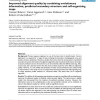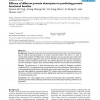80 search results - page 3 / 16 » Improved functional prediction of proteins by learning kerne... |
BMCBI
2006
13 years 7 months ago
2006
Background: Protein sequence alignment is one of the basic tools in bioinformatics. Correct alignments are required for a range of tasks including the derivation of phylogenetic t...
BMCBI
2007
13 years 7 months ago
2007
Background: Sequence-derived structural and physicochemical descriptors have frequently been used in machine learning prediction of protein functional families, thus there is a ne...
BMCBI
2008
13 years 7 months ago
2008
Background: Prediction of disulfide bridges from protein sequences is useful for characterizing structural and functional properties of proteins. Several methods based on differen...
RECOMB
2006
Springer
14 years 7 months ago
2006
Springer
Abstract. We describe and empirically evaluate machine learning methods for the prediction of zinc binding sites from protein sequences. We start by observing that a data set consi...
HAIS
2009
Springer
14 years 3 days ago
2009
Springer
Abstract. Protein membership prediction is a fundamental task to retrieve information for unknown or unidentified sequences. When support vector machines (SVMs) are associated with...


